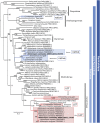Lateral transfers of large DNA fragments spread functional genes among grasses
- PMID: 30787193
- PMCID: PMC6410850
- DOI: 10.1073/pnas.1810031116
Lateral transfers of large DNA fragments spread functional genes among grasses
Abstract
A fundamental tenet of multicellular eukaryotic evolution is that vertical inheritance is paramount, with natural selection acting on genetic variants transferred from parents to offspring. This lineal process means that an organism's adaptive potential can be restricted by its evolutionary history, the amount of standing genetic variation, and its mutation rate. Lateral gene transfer (LGT) theoretically provides a mechanism to bypass many of these limitations, but the evolutionary importance and frequency of this process in multicellular eukaryotes, such as plants, remains debated. We address this issue by assembling a chromosome-level genome for the grass Alloteropsis semialata, a species surmised to exhibit two LGTs, and screen it for other grass-to-grass LGTs using genomic data from 146 other grass species. Through stringent phylogenomic analyses, we discovered 57 additional LGTs in the A. semialata nuclear genome, involving at least nine different donor species. The LGTs are clustered in 23 laterally acquired genomic fragments that are up to 170 kb long and have accumulated during the diversification of Alloteropsis. The majority of the 59 LGTs in A. semialata are expressed, and we show that they have added functions to the recipient genome. Functional LGTs were further detected in the genomes of five other grass species, demonstrating that this process is likely widespread in this globally important group of plants. LGT therefore appears to represent a potent evolutionary force capable of spreading functional genes among distantly related grass species.
Keywords: Poaceae; adaptation; genome; horizontal gene transfer; phylogenetics.
Copyright © 2019 the Author(s). Published by PNAS.
Conflict of interest statement
The authors declare no conflict of interest.
Figures






References
Publication types
MeSH terms
Substances
Associated data
- Actions
- Actions
Grants and funding
LinkOut - more resources
Full Text Sources

